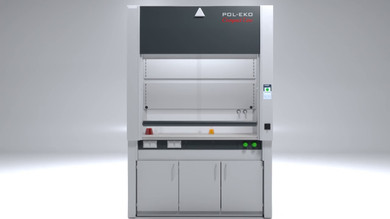Fume Hoods FAQ
Laboratory fume hoods (also known as fume cupboards) are an important safety measure in many laboratories that work with chemicals. They act as a ventilation system and prevent dangerous fumes, gases, vapours and dust from harming laboratory staff. Fume hoods are considered as a piece of laboratory furniture and can be found in most laboratories that have to work with any hazardous substances.
Why are fume hoods necessary?
Ensuring staff protection against dangerous fumes, chemicals, gases and vapours - fume hoods are an undoubtedly necessary part of lab equipment. Whenever laboratory activities include work with hazardous substances, it is important to perform these procedures under a fume hood. In addition to protecting personnel, fume hoods are also helpful in protecting the object of experiment and the environment nearby (from the exhausted vapours). Fume hoods play a crucial role in preventing the release of hazardous substances into the environment. By containing and controlling the fumes and particles produced during experiments or chemical processes, fume hoods help minimize the contamination of air, water, and surrounding surfaces. Fume hoods also help mitigate the risk of fires and explosions in the laboratory.
How do fume hoods work?
Fume hoods work like many other ventilation systems, as they draw in and capture the air. The difference with laboratory fume hoods is that they filter out all of the hazardous air gases, vapours, fumes, etc. The exhaust system removes the captured contaminants, preventing their dispersion into the laboratory. By maintaining a specific face velocity and using proper sash control, fume hoods ensure the containment of hazardous substances and the protection of personnel working within the hood's confines.
What are the types of fume hoods?
There are several types of fume hoods available, each designed to meet specific needs and requirements in different laboratory settings. Here are some common types of fume hoods:
- Ducted Fume Hoods: Ducted fume hoods are the most traditional and widely used type of fume hood. They are connected to an exhaust system through ductwork, which carries the captured fumes and contaminants to the outside environment. Ducted fume hoods provide effective containment and removal of hazardous substances.
- Ductless (Recirculating) Fume Hoods: Unlike ducted fume hoods, ductless fume hoods do not require an external exhaust system. Instead, they use filtration systems to remove or neutralize contaminants from the air before recirculating it back into the laboratory. Ductless hoods are suitable for applications where venting to the outside is not feasible or where containment of specific chemicals is required.
- Variable Air Volume (VAV) Fume Hoods: VAV fume hoods are designed to automatically adjust the airflow based on the position of the sash. As the sash is lowered, the hood senses the reduced opening and decreases the airflow accordingly. This helps save energy by reducing the volume of air being exhausted without compromising containment.
- High-Performance (Low Flow) Fume Hoods: High-performance fume hoods are designed to provide effective containment while minimizing energy consumption. They typically incorporate advanced airflow management systems, such as aerodynamic sash designs, baffle systems, and airfoil profiles. These features optimize airflow patterns and reduce the volume of air required, resulting in energy savings.
- Walk-In Fume Hoods: Walk-in fume hoods are large, enclosed structures that allow laboratory personnel to enter and work within the hood. They are suitable for handling large equipment or conducting experiments that require a significant amount of workspace. Walk-in fume hoods provide ample room for multiple operators and large-scale operations.
- Auxiliary Fume Hoods: Auxiliary fume hoods are designed to supplement the airflow and containment of an existing fume hood. They are typically smaller and placed near the primary fume hood to enhance containment for specific procedures or experiments.
- Radioisotope Fume Hoods: Radioisotope fume hoods are specialized hoods designed for working with radioactive materials. They provide additional shielding and incorporate features like lead-lined walls, filtered exhaust systems, and HEPA filters to capture radioactive particulates.
These are just a few examples of the different types of fume hoods available. Each type has its own advantages, considerations, and suitability for specific applications. It's important to consult with experts, manufacturers, and relevant safety guidelines to determine the most appropriate type of fume hood for your laboratory requirements.
How often should fume hoods be tested?
As laboratory fume hoods have a task as important as protecting staff, it is crucial to make sure that this piece of equipment is operating properly. The frequency of testing and certification for fume hoods can vary depending on several factors, including local regulations, industry standards, and the specific requirements of the laboratory or institution. It is important to consult relevant guidelines and regulations applicable to your location.
As OSHA (Occupational Safety and Health Administration) suggest, you should make fume hood performance tests at least once a year or every three months. Many guidelines and standards recommend annual testing and certification for fume hoods. An annual evaluation helps ensure that the hood continues to meet safety and performance criteria and provides adequate containment of hazardous fumes.
However, in addition to annual testing, regular visual inspections and checks should be performed on a more frequent basis. These inspections can help identify any visible damage, leaks, or other issues that may compromise the effectiveness of the fume hood. It is also advised to conduct verification testing on your fume hood whenever maintenance or repairs have been performed. This ensures that any adjustments or modifications made during maintenance have not affected the hood's performance.
How to check if your fume hood works properly?
Regularly checking the performance of a fume hood is crucial to ensure its proper functioning and the safety of laboratory personnel. The procedure is quite simple. As YSU Department of Chemistry suggests, 1) start with turning on the hood; 2) then check if the vaneometer ribbon doesn‘t need replacement; 3) match the red arrows in sash and on the side of the hood‘s panel; 4) in order to see the data, hold the vaneometer in the center of the hood; 5) check if the fume hood operated at a face velocity of 80-120 linear feet per minute. You can read their full instructions here.
Remember to consult the manufacturer's guidelines, local regulations, and safety protocols specific to your fume hood model and laboratory environment. Regular inspections, verifications, and maintenance are essential to maintain the integrity and functionality of fume hoods and to protect laboratory personnel from potential hazards.
Where do fume hoods vent to?
In many cases, fume hoods are connected to a building's exhaust system. The exhaust system is typically designed to remove the captured contaminants from the fume hoods and release them outside the building. This is done to prevent the contaminants from recirculating into the laboratory or other occupied spaces within the building. The exhaust air from the fume hoods may be vented directly outside through dedicated exhaust stacks or ducts located on the roof of the building. These stacks are designed to ensure that the released air is dispersed away from any occupied areas or air intakes to minimize the potential for re-entry of the contaminants.
It's important to note that the specific regulations and requirements for fume hood exhaust vary by jurisdiction, and there may be local codes or guidelines that dictate the proper venting and treatment of the exhaust air. Compliance with these regulations ensures the safe and effective operation of fume hoods and the protection of laboratory personnel and the environment.
Do fume hoods have filters?
Some laboratory fume hoods have filters. The presence of filters in a fume hood depends on the type and purpose of the fume hood, as well as the specific needs of the laboratory. While filters can be an important component of some fume hoods, others may rely solely on the ventilation system for containment and exhaust without filtration. Some of the types of filters used in fume hoods, include:
- HEPA filters - commonly used in biological safety cabinets, which are a type of fume hood used for handling biohazardous materials. These filters help prevent the release of airborne pathogens into the laboratory or surrounding environment.
- Activated carbon filters - used to adsorb and remove gases, vapors, and certain volatile organic compounds (VOCs). Activated carbon filters are effective for removing odors, organic solvents, and other volatile chemical compounds from the air.
- Particulate filters - designed to capture and remove solid particles suspended in the air. Particulate filters help prevent dust, powders, and other solid particles generated during laboratory procedures from being released into the environment.
It's important to note that not all fume hoods have filters. Some fume hoods rely solely on the capture and exhaust of contaminated air through the ventilation system without filtration. These types of fume hoods are typically used for general chemical handling applications, where the focus is on containing and exhausting fumes rather than filtering specific substances.

